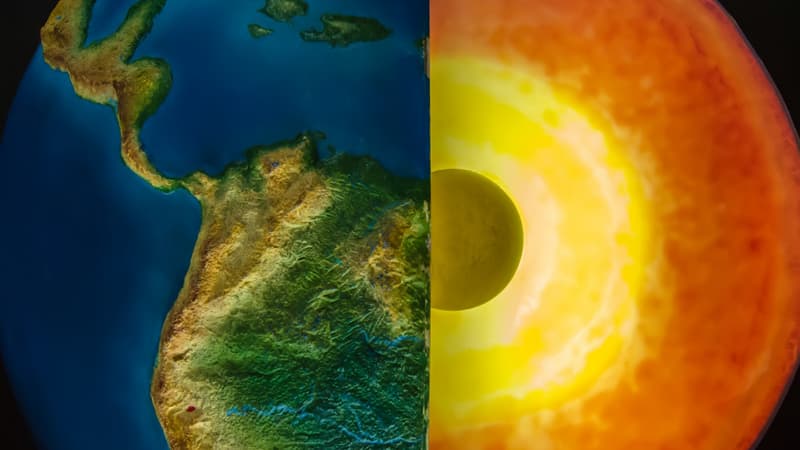Imagine. Located 5,000 kilometers below our feet, a ball with a diameter of 2,446 km rotates on itself, floating in a metallic soup. This is the inner core of our planet, made up of an alloy of iron and nickel heated to more than 5500°C. Discovered in 1936 by the Danish seismologist Inge Lehmann, it has never ceased to fascinate scientists.
“It is incredible that there is a solid metal ball floating in the middle of the Earth”, he marvels again at the New York Times John Vidale, a seismologist at the University of Southern California.
Especially since he hasn’t finished revealing all his secrets to us. In a study published Monday in the journal geoscience of nature, two seismologists from Peking University, Yi Yang and Xiaodong Song, suggest that the “seed” of our planet responds to a 70-year cycle. Every 35 years it would change its direction of rotation. And we would be going through one of those changes.
Stoppage of rotation between 2009 and 2011
To reach their conclusions, the two scientists studied seismic waves recorded from the 1960s to the present, caused by earthquakes and nuclear tests. Because although the inner core, located too deep, is impossible to study directly, the waves that reach it are not.
However, if the inner core were inert and content to follow the direction of Earth’s rotation, the seismic waves measured by scientists would always take the same path. But over time, this “path” differs. At the end of the 20th century, Professor Xiaodong Song already suggested that this metallic ball was moving at a different speed than our planet.
This Monday, together with his colleague Yi Yang, he presents a more detailed scenario. In 1970, the “seed” stopped. It then gradually began to turn to the East, before exceeding the direction of Earth’s rotation, then slowing down, finally stopping between 2009 and 2011. Since then, it has restarted its rotation, but this time to the West. It should mark a new stop in 2040, before heading back to the Orient.
An oscillation every seven decades?
To reach these conclusions, the Chinese scientists first analyzed seismic waves that have taken place since the early 1990s. They showed little change in trajectory over the past decade.
“This globally consistent pattern suggests that the rotation of the inner core has recently stopped,” they explain in their study.
“We compared this recent pattern to seismic records from the South Sandwich Islands dating to 1964 and it appears to be associated with a gradual return of the inner core as part of a roughly seven-decade oscillation, with another tipping point early in the decade. from 1960. 1970”, they detail.
“We only have 57 years of data, so you have to take it with a grain of salt. (…) When we have 50 more years of data, we will have more perspective to believe in this value. In any case, this seems to show a very long trend “, details the Parisian Séverine Rosat, geophysicist at the University of Strasbourg.
An arm wrestling under our feet
To explain this possible change in rotation, the two scientists evoke a confrontation that takes place under our feet to take control of the inner core. as pointed out New York Times, Yi Yang and Xiaodong Song believe that the earth’s magnetic field rotates the inner core in one direction. But this momentum is counteracted by the Earth’s mantle and its immense gravitational field, which slows down the rotation of the metallic ball that is the inner core.
Does this fierce fight under our feet have an impact on the surface? Chinese seismologists believe that if so, the consequences are minor. The change in the rotation of the inner core could slightly modify the magnetic field of our planet, causing a very slight alteration in the length of the day, which is known to increase and decrease by a fraction of a millisecond every six years.
Will we ever know for sure what is going on under our feet? I’m not so sure, says Professor Vidale interviewed by the New York Times, which anticipates the current technical impossibility of accessing this underground sanctuary. “It is quite possible that we will never find out the truth. (…) But I am optimistic. The pieces will eventually come together one day,” he says.
Source: BFM TV


